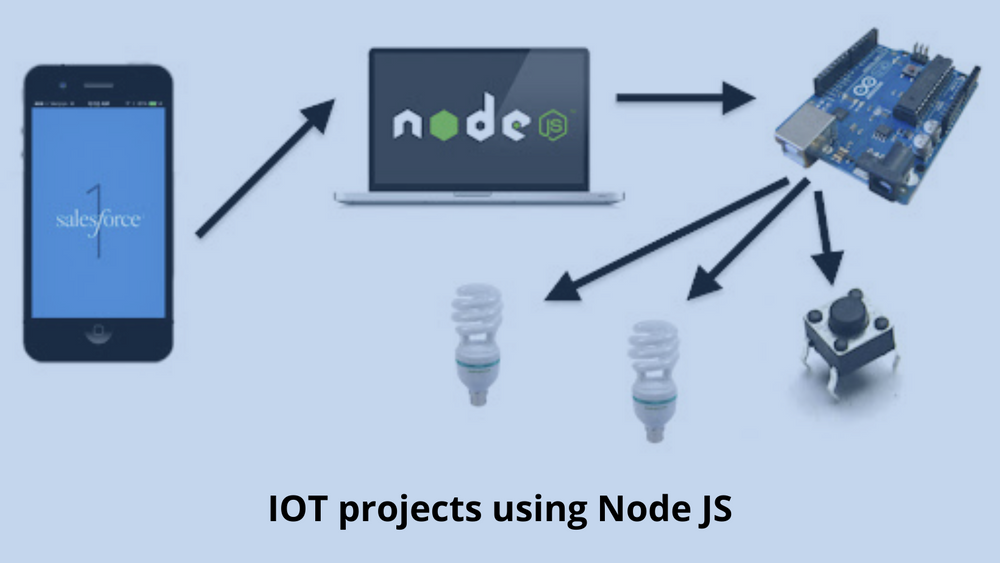IOT projects using Node JS
Hello People. This article discusses about building IOT projects using Node JS. The client-side of an IoT device is represented by the hardware itself. It is programmed using C, C++, which are low-level and difficult programming languages. Along with high performance, users of IoT devices prioritize low cost and energy-efficiency. As a result, at least for now, you should keep working with low-level languages.
However, the server side of IoT applications offers you more freedom of choice. You are not limited by the hardware here. One can choose any coding language and framework.

Advantages of using Node.js on the server side
IoT devices are constantly working with dynamically changing data. This means that you need a framework which can handle real-time applications and heavy data flows.
Are you looking to start your business in the electric vehicle industry? We provide software development, web application development, mobile application development, charging stations management app, electric vehicle fleet management software development, cyber security and all software services. Please check our home page here https://iwheels.co/

Ok. Let's get back to the article.
Node.js is built on Google’s V8 JS engine, which is highly effective and perfectly scalable. Node.js is the number one framework to be used with real-time apps and platforms.
Node.js is easy to integrate with IoT protocols. IoT applications actively use a publish-subscribe-based messaging protocol, MQTT. In turn, for transportation and encapsulation, this protocol uses WebSockets. Both MQTT and WebSockets are well-supported and easily integrated with Node.js.
Node.js modules facilitate IoT development. Node.js is augmented with npm, which features a lot of useful IoT modules. There are about 80 packages for Intel IoT Edison, Arduino, or Raspberry Pi. Also, it features over 30 packages for different sensors, beacons, and other tools.
Node.js is resource-efficient and scalable. Developers prefer working with Node.js because it does not require a lot of resources. The CPU and RAM are not overloaded. Moreover Node.js is highly scalable.
Security is one of the top problems in IoT. There are a lot of tools for authentication in Node.js like tokens, JSON web tokens, Auth0, and so on. However tokens are effective but not 100 percent safe. A token can be encrypted with any algorithm. However, the hardware (scanners, sensors, hubs, or other IoT things) should store this token or login/password data in firmware. This means that attackers can steal the token if they have physical access to the hardware. The same applies for JWT or Auth0.
But we can use any tools for authentication on the server side. You can easily integrate any authentication tool on the Node.js platform. There are a lot of npm packages which allow you to do this manually: Auth0, Passport, and JWT. There are also packages for integration with cloud IoT services: @azure-iot/authentication, aws-iot-device-sdk, and so on.
Secure HTTP requests are very important. Be careful with HTTP requests from your IoT devices. You should check if you get a request from a proper IoT device. Firstly, you should implement HTTPS with your IoT devices. Hardware is not a browser and you should implement HTTPS manually. For the server-side, you can either do it manually or use hosting with HTTPS configuration and certificates.
In Node.js, it is quite easy to implement:
const express = require('express');
const https = require('https');
const http = require('http');
const fs = require('fs');
const options = {
key: fs.readFileSync('path/to/your/key.pem'),
cert: fs.readFileSync(path/to/your/certificate.cert')
};
const app = express();
http.createServer(app).listen(80);
https.createServer(options, app).listen(443);
HTTPS uses SSL or TLS protocols for data encryption. Additionally, to be sure that you have gotten a request from the necessary server or client, use additional data encryption. For example, this is how you can use a signature:
const fetch = require('node-fetch');
const verifier = crypto.createVerify('RSA-SHA1')
const SIGNATURE_FORMAT = 'base64';
//check if it trusted url for your certificate
const trustedUrl = ‘https://trustedUrl/’
const isTrustedUrl = trustedUrl.match(url);
If (isTrustedUrl) {
verifier.update(req.body, 'utf8')
fetch(isTrustedUrl)
.then(certificate => {
// check signature
const isValidSignature = verifier.verify(certificate, reg.header.signature, SIGNATURE_FORMAT);
})
.catch(err => console.log(err));
}First, you have to check the trusted URL of your certificate. Then, you sign a request body with the public key from your certificate. Finally compare the signed body with the signature from headers. It is extremely important to know that you're getting requests from the proper devices and that you are not facing a middle attack.
Hope this article on IOT projects using Node JS is useful to you. Please read about Tata power EV charging stations in Andhra Pradesh




